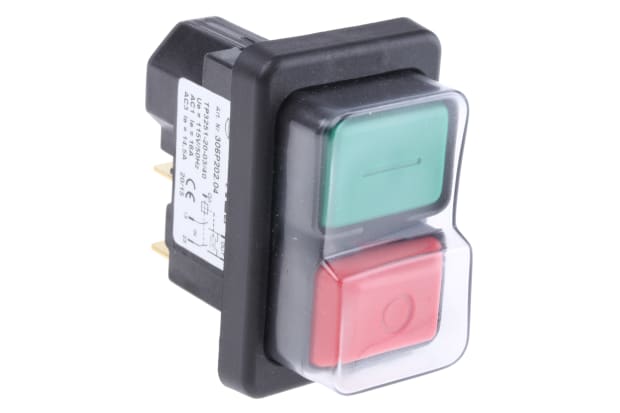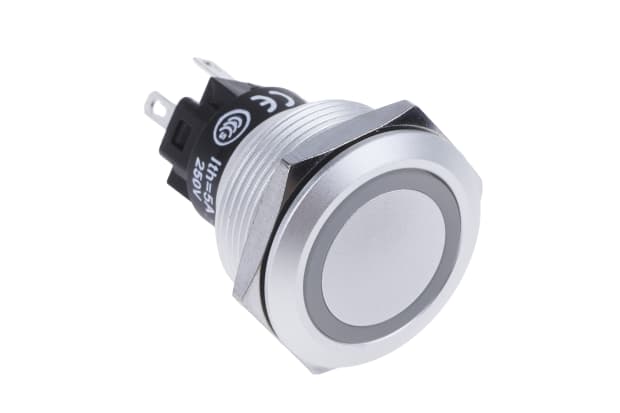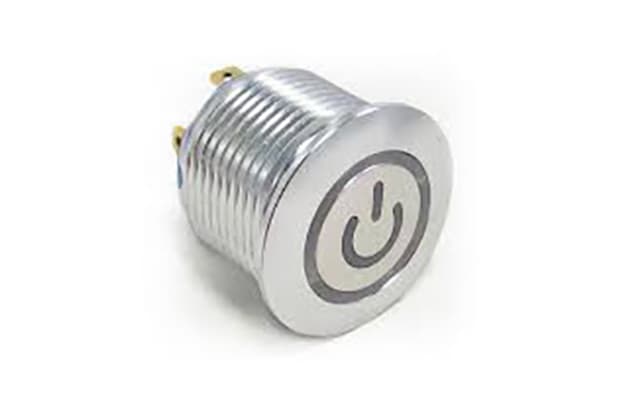- Published 12 Jan 2023
- Last Modified 27 Jun 2024
- 8 min
A Complete Guide to Push Button Switches
Discover our comprehensive guide that explains what a push button switch is, simplifies its workings, explores its practical applications, discusses different types, and introduces popular brands in the market.

What is a Push Button Switch?
A push button switch serves as a control mechanism, initiating actions in machines and various processes. Found in homes, workplaces, and outdoor environments, these switches are commonly known as pushbutton switches or push switches.
The buttons are typically made from plastic or metal and the push button may either be flat or customised to ergonomic specifications. A basic electrical mechanism or air switch mechanism may be included to turn it on or off. There is a wide variety of button switch types and models, which are powered either by momentary or latching action.
How Does a Push Button Switch Work?
Most push button switches function in the same way. Pressure is placed on the button or actuator, resulting in the depression of the internal spring and contacts and the touching of stable contacts at the bottom of the switch. This process will either close or open the electrical circuit. The repeat application of pressure will cause the spring to retract and alter the status of the push button connection.
You can choose between push buttons featuring normally open or closed contacts, which change state upon actuation. Continual pressure must be maintained on the button of a momentary switch to prompt the action. However, it will remain in a stable state within a latching push button until pressure is reapplied.
Push Button Switch Diagram
The diagram to the right demonstrates how a push button can be used alongside an ignition switch as part of a quick start ignition circuit.
This schematic shows the basic circuit design and wire layout required for this particular application.
Push Button Switch Applications
Push button switches have a wide range of applications and are commonly integrated within calculators, push button phones, and various domestic and workplace appliances. Such switches may turn the device on or off. Alternatively, they may cause a particular type of action, as is the case with a calculator.
In Hong Kong, push button switches are widely utilised across various industries, serving multiple purposes. They can be commonly found in household appliances such as washing machines, microwaves, and air conditioners for function control, or in consumer electronics to enable user input and control in devices like remote controls, keyboards, and portable devices.
Push buttons also play a crucial role in building automation systems, transportation systems, medical equipment, vending machines, and arcade games. Their versatility and reliability make them indispensable components in Hong Kong's diverse industries and various types of consumer products.
In many cases, the push button switch will have specific colouration to help denote their actions. This ensures that the chance of someone pushing the button by mistake is lower. For instance, red will usually indicate stopping, while green generally indicates starting a machine. Emergency stop buttons are generally large and red, and they typically have larger heads for easier use, ensuring enhanced safety.
Other push button switch applications include:
- Reset switches - they are often particularly small and may be switched on and off with a special tool
- Stopping machinery - distinctive push button switches are typically found on or next to industrial machinery, used to stop operation in the event of an emergency to ensure the safety of the workers
- Arcade gaming - these switches are often round and used to control elements of the game
Other uses of push buttons include:
- Toilet flushes
- Shower systems
- Light switches
Push Button Switch Types
There are many different types of push button switches, each with unique advantages. It is important to choose the most suitable type for your particular application. This will depend on factors such as the intended task, actuator style, and IP rating.
Common types include:
Momentary Push Button Switch
The user must press down on the actuator to power the momentary circuit on and off. This diagram highlights the operation of a momentary switch button. The triangles indicate the momentary action and the poles are specific to the number of circuits that the switch connects with during operation.
Arduino Push Buttons
With the support of an international community of creators, Arduino specialises in the development of easy-to-use hardware and software. The buttons are often connected to Arduino circuit boards, enabling them to control the function of an array of equipment.
2-Position Push Button Switches
These have two set positions for turning the connected device off-on. It is quite common for these switches to be encased in protective plastic, with a key being required for operation.
Dual Push Button Switches
Similar to the two-position variety, dual push button switches feature one button for electrical connection and one for disconnection. The on button is typically green; the off button red. LEDs are another common feature, with the backlighting indicating the status of the device.
Miniature Push Button Switches
Miniature or micro push button switches are available from a variety of brands such as C&K. They are often used for resetting small electronic devices.
Push to Break Switches
Also referred to as normally closed (NC), push to break switches are the most commonly used variety, operating oppositely to latching and momentary types. Electricity can flow to the circuit when no pressure is applied to the button. However, the flow will immediately be broken on pressing. The switch can remain on in either position, with the connection made and broken from separate devices.
Push to Make Switches
The push to make switch enables electricity to flow through the circuit whenever the two contacts are held in. The connection will be broken as the button is released. Common examples include doorbells, calculator buttons, and keyboard keys. Some feature both the push to make and push to break variety, depending on the wiring of the switch.
Square Push Button Switches
Square push button switches feature square buttons and come in a variety of colours. They are commonly found on items of machinery and automated equipment.
Circuit Board Push Button Switches
These circuit board switches restrict the circulation of electricity until the button is pressed. They operate through the process of user interaction and are commonly integrated on top of a printed circuit board. They are commonly used for powering keyboards, keypads, and interface control panels.
Tactile Push Button Switches
Also known as tact switches, these compact switches are commonly designed for mounting on PCB boards. They require a relatively small amount of force for adjustment of the switch and typically make a clicking noise to indicate whether or not the power is circulating. Some tactile switches also feature LED illumination. This illuminated functionality signals that the device is in the on or off state, or experiencing a fault.
Panel Mounted Push Button Switches
Panel push buttons are specifically designed for attachment to sturdy mountings. Reference should be made to the technical datasheet to identify the panel cut-out size. They are commonly used to power electronic devices within domestic and workplace settings.
Latching Push Button Switches
A latching push button switch remains in the same state until pressure is applied. This type of switch must be pressed once more to return the electronic circuit to its initial state.
These diagrams show the relevant electrical symbols.
Push Button PCB Switches
These surface-mounted PCB switches are designed to fit directly over the top of the PCB. Through-hole or thru-hole varieties are connected via a drilled hole on the printed circuit boards, with soldering applied to pads on the reverse side. Conversely, surface mounted types are designed to attach directly onto the surface of the board.
Locking Push Button Switches
Locking push button switches feature a mechanical locking function. This prevents the button from jumping completely and immediately after release. It will need to be pressed one more time to be unlocked. It was a common feature of traditional television sets.
Industrial Push Buttons
These buttons typically take the form of complete built-in units, including the push button actuator, fixing collar, and contact block. They are designed for easy installation in areas requiring manual intervention and are ideally suited to industrial applications. Industrial push buttons may be installed to control the circulation of power to heavy machinery, ensuring that it can be immediately stopped in the event of an emergency.
Push to Make Door Switches
Surface-mounted push to make door switches are ideally suited to the electrical operation of sliding and standard opening doors. They are typically made from white plastic and are suitable for the full range of door types.
Push Button Switch Voltage Ratings
You should not make the mistake of assuming that a push button switch will be suitable provided that the current rating does not exceed the maximum circuit load. The specific difference between the AC and DC capacity is usually highlighted clearly on the switch.
The required circuit breaking speed will depend on whether there is an AC or DC connection. The nature of the electrical load must also be taken into consideration, with suitability depending on the switching of an inductive or resistive load.
Popular Push Button Switch Brands
RS Components stock push button switches and accessories in a wide array of specifications, sizes and terminal options.
Our products are sourced from respected manufacturers, including:
APEM
Browse the extensive range of push button switches available from APEM and shop online with RS Components.
EAO
Explore EAO push button switches and discover the most suitable product to meet your requirements.
RS PRO
Click through to view the wide range of push button switches available from RS Pro, our own in-house brand.
TE Connectivity
Leading brand TE Connectivity offers a range of high-quality push button switches. Buy online with RS Components.


/Industry%20Hub/rs-pro.jpg)
